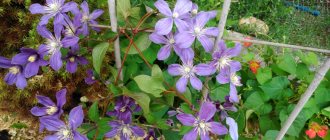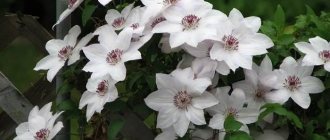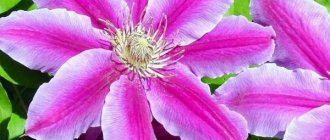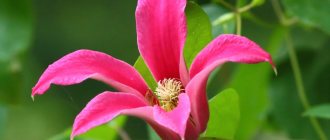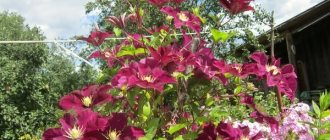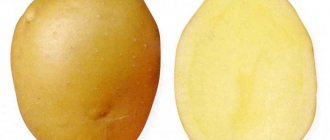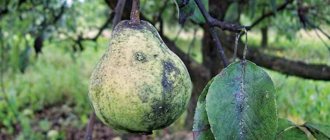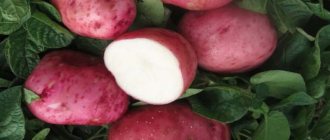Plants » Flowers
0
320
Article rating
Kira Stoletova
Large-flowered clematis Niobe is an achievement of Polish selection. It was released in 1975. The plant belongs to the Jacqueman group and is suitable for cultivation in all regions of our country. Let's consider the characteristics of the variety, the rules for its planting and care.
Clematis niobe description
Description of clematis Niobe
Clematis variety Niobe is a climbing vine that requires support to which it clings with leaf petioles and reaches a height of 2.5 - 3 m. The growth force of young shoots is moderate.
A large-flowered variety, the buds of which bloom from the second ten days of May to the third ten days of June. Second wave: from late June – early July and bloom until the end of September. Flowering occurs in two waves, on last year's and young shoots, without completely losing their bright color. Blooming, the buds of clematis Niobe acquire a black-burgundy color, gradually changing shades, becoming ruby red, with velvety shiny petals. The diameter of a blooming Niobe is 15 cm, the flower consists of 6-8 bright, pointed sepals, which are wide at the base and narrow towards the end. The stamens and pistils are bright yellow. Clematis variety Niobe begins to bloom profusely in the 3rd-4th year; in the first 2 years a small number of flowers appear.
The fruit is a multi-nut with numerous seeds, pinnately pubescent, of medium size.
The leaves are compound-trifolate, pointed, the edges are entire, dark green above, light green below with well-defined veins.
The root is strong, fibrous, penetrating deeply into the soil.
Frost resistance, drought resistance
Clematis Niobe is a frost-resistant variety that is suitable for growing in zones 3b, 4-11. The root system can withstand temperatures down to – 35°C, which makes it possible to grow in most of Russia, especially in the middle zone, and it is also possible to grow in Siberia.
Clematis variety Niobe is adapted to growing in dry areas, with more or less moist soil, but not in excess. It can do without watering for a long time, but in hot weather with strong winds, when the soil begins to crack, it requires moistening the soil.
Resistance to diseases and pests
Clematis Niobe does not differ from other varieties in its strong immunity to diseases and pests. It is also susceptible to fungal diseases, especially if the agricultural practices of planting and growing are violated.
Clematis is often susceptible to diseases:
- wilt (withering);
- rust;
- root rot;
- ascochyta blight (leaf spotting);
- gray rot;
- powdery mildew;
- Alternaria blight;
- mosaic;
- necrosis;
- cylindrosporiosis.
It is very important to follow the rules of care and cultivation for clematis Niobe, as well as to carry out preventive measures, spraying in spring and autumn with preparations with a fungicidal effect or spilling them on the soil. Diseased shoots must be immediately removed and burned to prevent re-infection.
Pests that most often appear on clematis varieties Niobe:
- aphid;
- mole cricket;
- small rodents;
- nematodes;
- butterflies and moths;
- spider mite;
- snails and slugs.
To eliminate parasites and insects, bait should be laid out on the site or repellent devices should be installed near the bushes. And also do not flood the soil around the clematis, make drainage grooves so that waterlogged soil does not attract pests. In spring and autumn, after spraying against diseases, treat clematis and the soil next to it with insecticidal preparations.
Diseases and pests
Infection with diseases and parasites is possible only if the rules of care and maintenance are violated:
Clematis niobe photo
- Rust. It can be identified by red or brown shapeless growths on leaves and stems. Infected areas darken, then die and crumble. Treatment is carried out using chemicals - first, the diseased areas are cut out, the crown is irrigated with Ridomil Gold, Skor or Hom.
- Powdery mildew. The causative agent is a fungus. Appears in damp and rainy weather. Looks like a white coating on foliage and shoots. Over time, it darkens and the diseased parts die off. First you need to cut out the infected areas, then irrigate the crown with chemicals - Bordeaux mixture or copper sulfate.
- Leaf chlorosis. This disease affects shrubs with a lack of iron in the soil. The situation can be corrected by feeding the vine with chelate preparations.
- Aphid. The insect multiplies rapidly and settles on the inside of leaves. It feeds on their juice, which leads to wrinkling, yellowing and shedding. At the initial stage of infection, you can do without chemicals - irrigate the crown with an infusion of tobacco, garlic or a solution based on laundry soap and ash. The advanced form is treated with pesticides - treated with Fitoverm or Karbofos.
- Caterpillars. They gnaw holes in the leaves, as a result of which the bush slows down its growth and loses its original decorative effect. Without timely treatment, only stems may remain on the bush. Treatment with insecticides is required - Actellik, Fitoverm.
- Nematode. A small insect damages the root system of a plant, as a result it ceases to receive moisture and nutrients. Necrosis of the aerial part develops. With such damage, it is impossible to save clematis, so it is dug up, burned, and the place of growth is spilled with a raspberry solution of potassium permanganate or copper sulfate.
- Spider mite. Appears in extreme heat and drought. Therefore, for prevention these days you need to spray the crown. The infected vine is treated with insecticides - Aktellik or Aktara.
To protect against diseases and pests, you need to buy healthy bushes and keep the area clean - promptly remove fallen leaves, remove weeds, regularly loosen the soil and trim off non-viable parts.
Planting and caring for clematis Niobe
The main rule for planting clematis variety Niobe: the root system should be in partial shade, shoots in the sun.
Recommended timing
Depending on the climate zone, clematis Niobe is planted in spring and autumn. For the Northern regions, planting is carried out in the spring, for the Southern regions in the fall. More favorable times for planting rhizomes: from mid-April to the end of May, from September to the first ten days of October.
Choosing a suitable location
Clematis Niobe grows well in areas facing south, southeast, southwest, in sun or partial shade. Clematis Niobe is planted in a place where there are no drafts, from buildings and fences at a distance of 1-2 m. The soil should be loose, well-drained, the soil should be sandy loam or loamy, the acidity level should be neutral.
Selection and preparation of planting material
Before planting clematis Niobe, you should choose a high-quality seedling without damage or dried roots, so it is better to purchase a specimen with a closed root system. Roots and shoots should be flexible, leaves bright green without damage, pests or diseases.
Before planting, the roots are soaked for 30 minutes in a disinfecting solution (manganese, phytosporin), the soil also needs to be spilled with it. Then inspect the roots and cut off any damaged or dry ones.
Landing algorithm
When planting clematis, Niobe must follow the following algorithm.
- After preparing the planting material, dig a hole 60-70 cm deep and 40-50 wide.
- Prepare a hole for planting, lay a drainage layer of stones and sand on the bottom.
- The excavated soil is mixed with rotted manure or grass, and peat, ash, and turf soil can be added.
- Prepare a future support for clematis and dig in a metal or wooden structure.
- Fertilized soil is laid on the drainage and a seedling is planted; warm water is watered on top, slightly moistening the soil.
- Sprinkle the remaining soil mixture on top.
Landing
Clematis are grown in gardens to decorate them, creating compositions according to the plans of landscape designers or the owners of the site themselves. Large plant sizes require adequate space, but if there is not very much of it, gardeners have to choose the planting site more carefully.
Choosing a place and time for landing
You need to choose a place to plant this plant, taking into account many of the nuances and characteristics of the plant:
- Clematis Niobe is a perennial plant; it can grow successfully in one place for about 30 years;
- the vine stems of clematis grow quickly and reach a height greater than human height in just one season;
- This plant is a light-loving plant; when shaded, flowering is short-lived and the size of the flowers is significantly reduced;
- the soil in the area where Niobe is supposed to be planted should be light and refined.
Young seedlings are planted in spring or autumn.
Selection of seedlings
The first rule when choosing clematis seedlings is to buy them only from nurseries that specialize in the production of ornamental climbing plants. Varieties and varieties of perennials should be selected taking into account the territorial capabilities of your garden. For a small area, clematis with lower stems are suitable. Also pay attention to the pruning group for varietal clematis.
In the video, a representative of the nursery where clematis planting material is prepared talks about the assortment available in their store (data from 2014):
Soil requirements
The soil structure for clematis Niobe should be loose and allow air and moisture to pass through well. Frequent watering compacts the soil, so it needs to be loosened, weeds removed, and mulched well in the spring with compost, tree bark or sawdust.
How to plant
Clematis Niobe, like all types of these plants, requires deep planting in the soil. The holes for planting are made quite deep (30-40 cm), plant seedlings should fit freely in them to a height of 10-15 cm above the root system. In order for the plant to begin to grow, and, therefore, to begin to bloom at an earlier date, they are first planted in separate containers; see how to do this correctly in the attached video.
Aftercare for clematis
Niobe can be grown by placing supports or leaving it to spread on the ground. The support can be a tree, a fence, pergolas, or a gazebo. Young vines should be tied to them using soft threads or ropes. The plant clings to the cuttings of the leaves, but may not hold tightly, which will damage the bush in a strong wind.
Watering
For the Niobe variety, moderate watering in the evening or morning is suitable throughout the spring-autumn period. Watering is carried out 1-2 times a week per 1 square. m. pour 8-10 liters. warm water. In dry weather, you need to increase the volume of water and the frequency of watering.
Top dressing
All clematis love rich soil, so they require fertilizer in spring and autumn, and the Niobe variety needs to be fed 3 times, adding fertilizer between flowering in July. In spring, fertilizers with nitrogen and potassium are needed, which will allow new shoots to grow quickly and flowers to set. In summer, complex fertilizers containing phosphorus, potassium, and nitrogen are applied. In autumn, the plant needs fertilizers with calcium, manganese, magnesium, phosphorus and nitrogen, or it can be fertilized with rotted organic matter.
Mulching and loosening the soil
In spring and autumn, to saturate the soil with micro and macroelements, the soil should be mulched with green manure, digging up shallow soil around the Niobe clematis. Loosening is carried out along with weed removal 3-4 times a month.
Origin and regions of growth
Clematis Niobe belongs to the Polish selection, its author was the famous flower grower Wladislav Noll. He presented his creation to the community in 1975. In the same year, the hybrid was registered with The Royal Horticultural Society (Royal Horticultural Society, London, UK). Almost throughout the entire territory of Russia, it is allowed to grow this clematis, since it has good frost-resistant qualities and, provided it is covered, can easily survive the winter.
Which pruning group does Clematis Niobe belong to?
Pruning group for clematis Niobe is the third, flowers are formed on new, young shoots. This variety has 2 waves of flowering, so the second group of pruning is also applicable for it. If you cover the vines for the winter, you don’t need to do any pruning; flowers will appear on last year’s shoots. The disadvantage of this method is that the roots will feed the old shoots more strongly, forming fewer new ones, making them weaker, which will affect the reduction in the formation of new flowers. Also, the bush will be very thickened, as a result of which fungal diseases may appear.
Pruning Clematis Niobe
To get early flowering in the spring, light pruning should be done in the first year, leaving 30-40 cm from the ground of healthy, undamaged shoots. In subsequent years, pruning is not carried out in the spring; it is carried out in the summer after the first flowering, cutting off faded shoots. In the fall, after flowering, shoots are cut off, leaving strong, undamaged shoots at a level of 1 m. Every 5-6 years, heavy pruning should be done.
Reviews
Elena, 33 years old, Perm
I planted two clematis seedlings, one of them is the Niobe variety. Its bushes grow up to the second floor of the dacha, blooming differently every year, sometimes almost none, sometimes all the vines have large flowers, maybe it depends on the weather, but I take care of them the same way.
Masha, 15 years old, Samara
Of all the flowers that my grandmother grows at the dacha, I like clematis with dark burgundy flowers, I don’t know what this variety is called, but they are wonderful and amazing.
Popular types and varieties
Clematis includes more than 300 valuable noble varieties, which differ in color and shape of flowers. New varieties continue to be developed to increase plant resistance to frost, adapt them to growing in containers, or try to create varieties that can replace ornamental shrubs.
Depending on the variety, you can grow species with large or small flowers, which grow well in the southern and northern parts of the garden. Varieties differ in appearance, vigor, flowering period and frost resistance. When growing clematis, it is worth considering that large-flowered varieties are much more sensitive and demanding than perennial and botanical varieties.
Large-flowered
The most popular in our gardens are large-flowered clematis. Their flowers are the most attractive - large, reaching 15 cm in diameter. They are magnificent and last a long time on the plant. Multi-flowered clematis often bloom twice and can decorate the garden all season long:
- flowers appear for the first time in May–June;
- then they repeat flowering on the shoots of the current year until autumn.
Among the easiest to grow large-flowered clematis are the following varieties:
- "Comtesse de Bouchau";
- "Gipsy Queen"
- "Hagley Hybrid";
- "Huldine";
- "Jackmanii";
- "Ramona"
- "The President".
Grape leaf
Noteworthy is the climbing clematis or clematis (Clematis vitalba), characterized by strong growth. The shoots reach a length of 10 meters in a short time. It is often planted in containers on the balcony. This is one of the most attractive climbing plants available for cultivation in our climate. The liana forms small flowers that densely cover the plant. There are really a lot of flowers, usually they are white.
Nowadays varieties with increased frost resistance are being developed, because previously these perennials often froze in severe winters. The most valuable variety of clematis with high frost resistance and magnificent, delightful lush flowers - “Summer Snow” Summer Snow has white, relatively large flowers.
Tangut
Interesting is the Tangut clematis (Clematis tangutica), characterized by drooping single yellow flowers appearing on thin stems. Tangut clematis has the advantage that its fruits are very decorative - fluffy and silky.
Notable varieties are “Anita” and “Bill McKenzie”, growing up to 6 meters in length. Tangut clematis is also available in varieties with intense orange flowers.
Alpine
Alpine clematis is excellent for growing in our gardens. These garden flowers are especially valued for their resistance to adverse weather conditions. They are great for any garden; you can even plant them in areas where cold winds often blow. Alpine clematis is suitable for cooler regions of the country, so it is very popular. The species is distinguished by bell-shaped flowers hanging from long peduncles, taking on beautiful, intense colors.
Alpine clematis has colorful varieties that are great for growing. It is even more frost-resistant than grape-leaved and grows well anywhere. Intense red or burgundy varieties are popular. Violet and blue shades are interesting - these are relatively rare flower colors, so it is worth making such a contrasting accent in the garden. The most popular varieties of alpine clematis include:
- "Blue Bird" Blue Bird;
- "Cecile" Cecile;
- "Frankie" Frankie.
Straight
In gardens you can find straight clematis, which also grows in wild form in our country. This is a small-flowered clematis with a stunning scent. The flowers are quite small, but numerous, so they do not lose their attractiveness. They look great in the garden; ornamental shrubs are good company for them.
Manchurian
Manchurian clematis (Clematis mandschurica) is unpretentious in care. This is an extremely undemanding plant that blooms beautifully almost all season. This is a vine reaching a height of 2 meters. The distinctive features of the species are small white flowers, reaching a maximum diameter of 2 cm. Their shape resembles scattered stars. Flowering period: July-September. An additional advantage of the plant is its wonderful aroma. White flowers look interesting against the background of green leaves. After the flowering period, characteristic fruits appear in place of the flowers, consisting of tiny hairs that form small “doughnuts”.
Nutrition and watering
Watering should be systematic. Clematis is very sensitive to drought, low humidity and lack of nutrients. Feeding should be done gradually. You can apply small doses of mineral fertilizers for the first time after the beginning of the growing season and during budding, and for the second time after flowering and summer pruning.
The crop should not be fed with fertilizers containing nitrogen later than the end of July, and with liquid fertilizers until the end of August. It is very practical to use slow-acting fertilizers rich in potassium, which are poured into the hole or around the plant once a year in the spring.
Step-by-step instructions for planting the Omoshiro clematis variety:
- First of all, you will obviously need a planting hole in which you will place the future decoration of your garden. Such a pit should have dimensions of 60 by 60 by 60 centimeters. However, these indicators may vary depending on the type of soil. The optimal distance between bushes is one and a half meters. Making it smaller is not recommended at all.
- When the hole is ready, you can pour drainage in the form of small crushed stone or broken bricks onto the bottom. The latter will work much worse, because after some time it will be significantly damaged by water. The approximate layer thickness is 15 centimeters.
- A little fertile soil, prepared in advance, is poured onto the drainage, so that a mound is formed on which we will plant the roots of the plant for its stability.
- The neck of the root of the planted clematis should be parallel to the ground, but a slight depth is still allowed.
- Now that the clematis is planted, you can fill it with soil and compact it well.
- Congratulations: your clematis has been successfully planted and to celebrate, it should be watered generously. Remember that the first watering is the most important in the life of almost any plant.
However, this does not mean that you need to overdo it. The fact is that clematis is a very moisture-sensitive plant and should not be watered too much. Therefore, you will have to constantly monitor that the moisture in the soil does not stagnate for a long time and constantly check the required amount of water.
After planting, it is very important to carefully monitor and care for your clematis. Especially for such a delicate and sensitive variety as Omoshiro
Therefore, you must follow these simple rules:
The most important rule for watering clematis Omoshiro, which we have not yet talked about, is regularity. It is better to water it less abundantly, but much more often
This way you are more likely to prevent not only waterlogging, which, as we found out, does not bring anything good with it, but also drying out of the soil, which you need to be careful of (especially in the early stages of clematis growth). No less important is feeding clematis. For its full and constant growth and development, the Omoshiro variety needs a large amount of nutrients, which it can obtain from fertilizers. It is simply necessary to feed young clematis at least three times a season. However, depending on the wishes of the gardener, this figure can be raised to four. The most important rule of fertilizing is that it is carried out exclusively after watering. Also, summer treatment of shoots with potassium permanganate will not be superfluous. The gardener's worst enemies, as we all know, are weeds. And you need to get rid of weeds that spread their roots around your clematis as often as possible. They are dangerous because they eat food and drink water intended for your plant, and do not allow it to fully grow and develop. No less important, and perhaps the most important procedure for caring for clematis is pruning. We talked a lot about her, but never clarified the details. So, for the first time, pruning according to the rules is carried out when the Omoshiro clematis turns 3 years old. Until this date, it is quite possible to carry out the same procedure for all pruning groups. This procedure is extremely simple, and it will be quite difficult to spoil anything. It consists in the fact that absolutely all shoots of the plant are cut off until only one bud remains on them. This will be quite enough for further development. Important! This variety of clematis has very strong stems, which slightly complicates the pruning process. Therefore, your tools should be as sharp as possible.
In June, Omoshiro clematis seedlings are pinched. In total, this procedure must be performed three times: the first time - when the shoots of the plant reach a length of 10-15 centimeters. The second pinching is carried out at 20-30 centimeters, and the third at 40-50 centimeters.
The last procedure you will encounter when growing the Omoshiro variety is replanting. The fact is that this variety reaches its maximum beauty at the age of 3-7 years. After this, its roots expand and intertwine, which leads to their greater need for water. Therefore, about once every seven years, clematis Omoshiro must be rejuvenated by transplantation.
Reproduction methods
Clematis "Ernest Markham": variety description and cultivation
There are several ways to obtain new seedlings from the mother bush. If you follow all the rules, each method will give a positive result.
Clematis niobe pruning group
Stem layering
For such propagation, a bush over 7 years old is suitable. Choose the most flexible shoot, located close to the soil. Remove all the leaves on it, bend it to the ground, and lay it in a horizontal position.
Sprinkle with a mixture of peat, humus and sand, mixed in equal quantities, and water. A week before the first frost, cover with fallen leaves, then spruce branches.
In the spring, when the snow melts, they remove the insulation, dig up a twig, and cut it off from the bush. Divide into several parts so that each has roots.
The cuttings are planted separately in fertile soil in the same way as purchased plants.
By dividing the rhizome
This reproduction is carried out in the spring. They use old bushes that have stopped growing and need rejuvenation.
Clematis is watered abundantly, dug up, placed in a bucket of water to wash away the remaining soil. The rhizome is dried, then cut into pieces with a garden shovel. Each division should have one shoot with several roots.
The cut areas are treated with a solution of copper sulfate and powdered with charcoal. Planted individually in a flower bed or flower garden.
Cuttings
Planting material is cut in spring or summer. Select stems of the current year with several buds. The optimal length of segments is 12-15 cm.
The leaves are torn off at the bottom, then dipped in Kornevin’s solution for an hour. For planting shoots, a seedling box or a plastic container with drainage holes filled with a peat-sand mixture is suitable.
The cuttings are deepened by 3-4 cm, watered with warm water, and covered with a transparent film. Place in a warm and well-lit place, where the temperature fluctuates between 22-25°C. Ventilate every day and moisten as the substrate dries.
As soon as they begin to produce new leaves, the cover is removed. They continue to care for another month so that they grow roots, then they are planted on the site.
Rules for watering hybrid clematis Asao
Clematis is a plant that loves moisture very much. However, it is absolutely afraid of stagnation of water, so special control is needed here on the part of gardeners. Optimal watering is approximately once every 5 days. If the summer is drier, then it is necessary to water more often. The water temperature should be sufficient, or better if it is rain water. An adult plant requires approximately 30 liters of water. Watering should be done not directly at the root, but at a distance of about 30 cm from it.
Experienced gardeners use a different method of watering, which will ensure the best moisture penetration to the roots. To do this, during planting, several pipes are dug in with holes pre-made in them, through which watering directly occurs. This will not only allow moisture to reach the root system, but will also prevent the appearance of fungal diseases, as well as erosion of the root zone and wetting of the leaves.
How to care for a plant
We have already said that clematis is unpretentious in terms of care. But in order for it to bloom as long as possible, it still needs to be looked after. There are not so many operations in this regard:
- regular watering;
- fertilization;
- weeding;
- pruning
As for watering the plant, clematis Niobe, like its other varieties, is very demanding of liquid; accordingly, it needs to be moistened especially carefully during the growth period.
Water it generously once a week, maximum once every 5 days. You can check how much the plant needs watering at a depth of about 20 centimeters, because this is where the root system of the flower is located. If the soil is dry, then it is necessary to water the plant. It is imperative to apply the necessary fertilizers so that the flower grows to the desired height; this requires a lot of nutritional components.
Since clematis of this species is a large-flowered plant, it is best to feed it once every two weeks. About 10 liters of solution is usually used for 1-2 bushes; you cannot save on this.
During plant growth, nitrogen is usually used for feeding. If the plant receives it in sufficient quantities, then powerful shoots will be provided, and the leaves will be green, and not yellow or red. But the lack of nitrogen can negatively affect the plant, which is why it must be constantly present in the soil during flowering.
Phosphorus is a very important element. Its absence can be determined by the fact that the leaves almost instantly turn purple, and the shoots develop very poorly. The best option for using this fertilizer is to add bone meal in early autumn along with the main fertilizing. Superphosphate is also used if necessary.
Pruning a plant and its group
Pruning is also an important component of care.
The success of clematis flowering depends on it. Pruning is performed several times during the season. The first pruning is done right at the time of planting; the shoots must be shortened to increase the duration of flowering. And the second pruning is carried out at the beginning of the flowering period. Lianas are cut back to the buds so that there are more new shoots. The last time clematis is pruned is before winter and the entire above-ground layer is removed.
In the first year after planting the plant in the fall, it must be pruned above the third pair of buds, depending on the pruning group and variety. This is done so that the plant takes root better, becomes stronger and bushes better.
There are three groups of pruning clematis:
- weak pruning - in representatives of varieties that bloom on last year's shoots, immature and weak shoots appear in winter. Other shoots with strong growth can be cut off by a third, but not shorter than 2 m from the ground, they also need to be laid on the ground and covered for the winter. And remember that varieties that bloom on shoots after wintering with double or semi-double flowers, due to severe pruning, may either not bloom at all, or bloom with simple non-double flowers on new shoots;
- moderate pruning - mainly large-flowered varieties begin to bloom on overwintered shoots, and then on the shoots of the current year. In winter, the shoots are shortened at a level of about one and a half meters from the ground, laid and covered;
- heavy pruning - this group concerns those clematis that begin to bloom profusely from the end of June; it is better to prune them later by 2-3 pairs of buds in autumn or early autumn. It is recommended to cover the plant for the winter.
Clematis Niobe is a perennial plant that can grow in one place for 25 years. For this reason, the site must be very well prepared before planting, as described in the material. And to protect the plant from overheating, you can place small summer houses around it. Before wrapping it up for the winter, be sure to remove any plant debris such as fallen leaves that are nearby.
This plant is not particularly demanding in care, but it should still be present if you want clematis to delight you with lush flowering.
https://youtube.com/watch?v=eo_mYQmyJK4
Growing clematis from seeds
From the point of view of growing from seeds, all clematis can be divided into three groups:
- with small seeds - germinate within a few weeks and have good germination. These are species of clematis - Tangut, grape-leaved, serrate;
- with medium seeds - they germinate from a month to six months, many do not germinate without stratification. These are six-petalled, Manchurian, whole-leaved clematis;
- with large seeds - they germinate for at least three months, and some even take a year. Germination and germination energy are poor; stratification is almost always required. These are varietal large-flowered clematis, woolly, Texas and others.
The best germination rate is for fresh clematis seeds, recently collected and dried. However, if the seeds were stored in a dry place at a temperature of about 20 degrees, they will remain viable for 3...5 years, although the proportion capable of germination will decrease every year.
The timing of sowing depends on the group: small seeds are sown in March, medium ones at the end of December, and large ones a couple of weeks after collection (they germinate so slowly that in the first year they may not even get picked).
Many seeds do not germinate or germinate poorly without prior soaking or stratification. Soak the seeds for 7...10 days in clean water, which is changed several times a day. stratify the seeds in the refrigerator for 10...30 days at a temperature of about 4 degrees.
After soaking or sowing, the seeds are sown in light nutrient soil with a neutral soil solution. they are distributed over the surface of the soil and sprinkled with wet sand. The thickness of the sand layer is 2...3 times the diameter of the seeds. After this, the containers are covered with glass or film and placed in a warm place.
The optimal temperature for seed germination is 25...28 degrees. During the entire germination period, the soil is moistened by pouring water into the pan. You can also water from above through a strainer. After the seedlings appear, the temperature is reduced to 18...21 degrees and placed in a well-lit place.
Features of flowering and application in landscape design
The flowering time of this clematis hybrid depends on the region of growth. The first buds in the middle zone appear on the plant in July, and the last ones delight the eye in September. In the southern regions, flowers can appear on clematis until late autumn.
Due to its compactness, the vine is used not only to decorate a personal plot - gazebos, arches, walls of buildings and fences.
Also, many clematis lovers grow it as a potted crop on balconies and loggias. If you plant a bush near a tree, in a few years the vine will completely entwine it.
Care methods
Clematis Niobe needs to be looked after very carefully so that it grows for a long time and blooms beautifully. The plant needs to be loosened, fed, weeds removed, and preventive measures taken against diseases and harmful parasites. Clematis Niobe is very moisture-loving, so it needs to be irrigated often.
Fertilizing and laying mulch
In the spring, it is necessary to apply organic and mineral fertilizer complexes. During the growing season and flowering, phosphorus, potassium and nitrogen fertilizers are added.
The soil needs constant loosening, this allows the soil to be saturated with oxygen, and this has a beneficial effect on plant growth.
Irrigation and pruning of large-flowered clematis variety Niobe
When the surface layer of soil dries out, you need to water the plant immediately. To prevent the liquid from stagnating, you need to drain the soil.
Clematis Niobe is classified as pruning group 3; flowers appear on this year's shoots. In autumn, new shoots need to be trimmed, but about 3 buds should be left. The remains of plants should be cut off and thrown into a compost heap, since by spring it will form good fertilizer for the plant crop. Clematis buds will begin to actively grow and bloom until the following autumn. You need to trim the flower once a year.
Covering the plant in winter
Despite the fact that the Niobe variety can withstand down to -40 degrees, the bushes still need to be covered with a thick layer of sawdust 30 cm and a layer of peat, making it no more than 10 cm.
How to fight parasites and diseases
The plant is not very resistant to pests and diseases; it, like most plant crops, can suffer at any time. In the spring, Clematis is treated with Actelik, copper sulfate, Bordeaux solution and Fundazol.
Preparing for winter
Clematis "Ashwa" corresponds to the third or fourth frost resistance zone. This means that it tolerates frosts well, during which the temperature drops to -30 or even -35 degrees, but only if the cold weather is short-lived. If the region has harsh winters, then the root zone will have to be insulated with peat back in November. However, when the temperature drops to -5 in December, this procedure is carried out earlier. When temperatures regularly drop to -40 degrees or more, it is necessary to organize multi-level protection for clematis, consisting of soil, peat and spruce branches. In spring, all these layers are gradually removed.
General characteristics of varieties
Plants belonging to the Jacquemman clematis group look very different in the photo. However, they have a number of common properties. We present them in the table:
| Parameter | Characteristic |
| Genus | Clematis or Clematis |
| Growth form | bush liana |
| Type | Large-flowered |
| Group | Jackman (Jackmanii) |
| general characteristics | A climbing, abundantly flowering, unpretentious plant with a powerful root system |
| Purpose | Vertical and ground cover gardening in landscape design |
| Life cycle | Perennial |
| Reproduction methods | Seeds, cuttings, dividing the bush, layering |
| Shoot length | From 1-1.5 m (for low-growing varieties) to 3-4 m (for tall varieties) |
| Flowering type | On the shoots of the current year |
| Flowering time | End of May (beginning of June) – mid (end) of September (depending on the growing region) |
| Flower sizes | 8-15 (up to 20) cm in diameter |
| Flower coloring | Mainly blue-violet-purple tones |
| Trimming group | 3rd (radical pruning for winter is required) |
| Sustainability | Not too demanding on weather and climatic conditions and the level of agricultural technology; Some varieties are resistant to diseases and pests to varying degrees |
| Registration in the State Register of the Russian Federation | Not included |
Plants of the varieties of the clematis group "Jacman" differ significantly from each other in appearance, but have a number of common properties
With regard to flowering, clematis "Jacmans" has the following features:
- plants form buds of an elongated conical shape, directed sideways or upwards;
- the flowers, as a rule, are simple (not double), open, “looking” up or to the side. Drooping forms are rare;
- There are from 4 to 6-7 petals. They have an ellipsoid shape, pointed tips, and a smooth or velvety surface. May wrap outward or partially overlap each other;
- The color of the flowers is bright. Dark shades of purple, violet and blue predominate. In some varieties, the petals have a bicolor (with stripes of a different color) or gradient (with changes in the intensity of the main tone) color.
Large clematis flowers with petals that have a two-color or gradient color look especially impressive.
The resistance of varieties of the group to diseases and the degree of susceptibility to pests may vary, but all these plants are not very demanding on weather conditions and the intensity of agricultural activities. Most varieties can be grown in almost any climate zone of our country.
Use in decoration
Clematis Niobe is simply a godsend for landscape design. This plant will decorate any corner of the site. You can plant a vine along the fence and thereby create an imitation of a hedge. The plant is often used when decorating a recreation area. Bindweed looks ideal on arbors and decorative supports.
Planting clematis and caring for it in open ground will not cause much trouble. And in return, the site will have indescribable beauty and comfort. Twice a season, unusual bright flowers will decorate your garden plot. And the rest of the time, green vines decorate the garden plot favorably.
